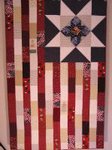Amy, Diabetes Mine, is the host for this week’s Grand Rounds! You can read this week’s edition here.
The Ides of March is the first day of the Roman New Year. It also marks the first day of spring in the Roman calendar.On this day in history, Julius Caesar was warned by soothsayers to “beware of the Ides of March”. Apparently, he did not heed the warning strongly enough as he was stabbed by Marcus Brutus on the Ides of March in 44 BC.We must begin with last week’s betrayal by the forces of nature, as Dr. Paul Auerbach, of Stanford Emergency Medicine, voices our feelings at Heathline:“Our thoughts and prayers go out to everyone in harm’s way related to the earthquake and tsunami that just struck Japan, as they did for persons in New Zealand, Haiti, and every other country recently affected by a natural disaster.” ……
……………………………
A wonderful post by Michelle Au, the underwear drawer : it gets betterThe lowest point in my residency was in January of my intern year. I was a Pediatrics resident back then, doing a month-long rotation on "Team 2," which is what we called the general inpatient pediatric team, with a focus on the patients on our liver transplant service.
It was a very long month.…………..
……………….………….
Via both @movinmeat and @inwhiteink: Satellite Photos - Japan Before and After Tsunami - Interactive Feature - NYTimes.com
and to @movinmeat: @arclight this is an excellent, if long/wonky explanation of what happened at Fukushima Daichi nuclear plant Why I am not worried about Japan’s nuclear reactors
New York Times: 100 Photos of Japan Aftermath
…..If you are looking for ways to help Japan, consider donating to the Red Cross: Japan Earthquake and Pacific Tsunami Relief
or if you’d rather do so by texting: Donate to @SalvationArmyUS by texting "JAPAN" to "80888" or text "REDCROSS" to "90999"
Other good sources for information can be found in Thomas Fiala, MD’s post: OT: Information on Japanese earthquake & tsunami relief efforts
…………………………………………
Two stories from NPR:
Radiation Fears Rise At Japanese Plant by NPR Staff and Wires
Dangerous levels of radiation are leaking from the earthquake-crippled Fukushima Daiichi nuclear power plant north of Tokyo and levels are rising, Japanese Chief Cabinet Secretary Yukio Edano said Tuesday.Japanese Prime Minister Naoto Kan ordered everyone within 20 kilometers (about 12 miles) to evacuate. He told everyone within 30 kilometers (about 19 miles) to go inside. Japan's NHK television said most residents inside the 20-kilometer radius have already evacuated. ………….
Why Iodine Tablets Come Out When Radiation Threatens by Scott Hensley
Just in case, Japan has distributed a whole bunch of potassium iodide to evacuation centers near the troubled Fukushima Daiichi and Fukushima Daini nuclear power plants.The International Atomic Energy Agency said in a statement that 230,000 units (the stuff comes in tablets and as a liquid) are at the ready.Why is that important? Well, one of the substances that can be released in a nuclear accident is radioactive iodine (I-131, if you're interested in the details). And some radioactive iodine has already been detected by Japanese authorities. ……….
……………………………..
H/T to @globalsurgeon: An interview in IPS News of @ReinouGroen from @SurgeonsSOS on #globalsurgery : Needing Surgery Shouldn't Be a Death Sentence
Surgery saves the lives of millions of people around the world, but only a tiny percentage of them live in low- and middle-income countries (LMICs), where a shortage of skills, supplies and infrastructure can turn easily treatable accidents and illnesses into lifelong disabilities and even death.The world's poorest receive only four percent of all major surgical operations worldwide, while 75 percent of surgeries benefit the richest third of the world, according to a 2010 Harvard University School of Public Health study. …….
………………………………
Our medical blog friend, Dr Anonymous, has officially ended his old blog: Goodbye @doctoranonymous. He changed his twitter name last week: @drmikesevilla and has revealed his new website/blog: Family Medicine Rocks.
Best wishes to you, Dr. Sevilla!
……………………….
On a lighter note, this story comes from @KnittingNephron ---Knitted breasts created by 91-year-old pensionerYou might expect your granny to knit you a woolly jumper, but one pensioner has been defying expectations by using her needles to craft amazing knitted BREASTS.Coral Charles-Dunne, 91, from Birmingham, has knitted dozens of the unusual educational tools as part of a project to inform expectant and new mums about breastfeeding.She says spends about two hours creating each of the woolly boobs and makes them in a range of sizes, knitting for up to six hours per day. …………






